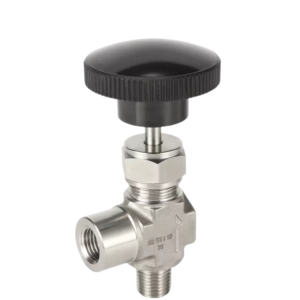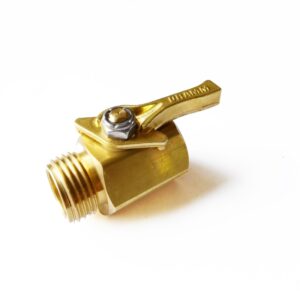Description
Brass three-way angle valve
JX-0222
Size 3/8*1/2*3/8
A 3-way water valve has a steady flow rate that can change the flow direction or mix different flow types. Because it has three holes that can be joined to tubes to let liquid or gas flow, it’s also called a multiport valve. Three-way water valves have these holes: two inlets, one exit, one input, and two outlets.
Even though it is a multiport valve, the flow rate in each valve stays the same. Though the liquid or gas will be split into two different holes, the flow rate stays the same wherever the valve is used.
This valve configuration permits one orifice to be open while the other remains closed, or conversely. As a result, the device can be conveniently used to apply pressure or to release pressure. Typically, three-way water valves are either closed, open, or universal.
As it adjusts various system conditions and permits diverse flow patterns in a conduit or whichever system it is implemented in, the 3-way water valve is considered by several 3-way water valve manufacturers as one of the most widely used valves.
What Are the Main Features of a 3-Way Water Valve?

Here are some of the best 3-way water valve features.
· structure:
With these valves, the third port doesn’t need its pipes or links. The 3-way water valve takes care of all of these extra problems and controls more than one valve simultaneously.
· Versatility:
The best thing about 3-way water valves is their versatility. They can easily manage flow in three ways and offer many tuning choices. Thus, they can be used in several different situations.
· Multiple Control Options:
Three-way valves are designed to maximize a single product’s performance. They offer different ways to control fluids, including processing media from the entrance by mixing, redirecting, or stopping it. They also maintain the flow very precisely. When flow accuracy is the primary goal, these are the best tools for the task.
· Less Expensive:
If you need more than one valve, you can use a 3-way valve. Instead of buying and installing different switches to control each media type, they do it for us. Also, they eliminate the need for a divider or blender. The best part is that 3-way valve prices are also very low.
· Self-Maintenance:
The three-way water valve’s construction can be changed and made to last. If the valve seat starts to wear away, it sets off a self-cleaning device. Higher-pressure fluids moving through the fluid wash away all kinds of buildups, improving the covering, which was worse because of the loss.
Low Resistance to Flowing Media:
The structure of these valves can change to fit the flow of media. A disc or plug keeps the pressure of the liquid steady at the entry and exit points, which means that the media has the least resistance and pressure drops.
Guidelines When Purchasing a Three-Way Water Valve
When buying a 3-way valve, you must remember these concerns.
· Reviews and Recommendations
Read consumer reviews before acquiring a three-way water valve. Request information regarding the experiences of potential buyers of similar valves. Their expertise may contribute to your dependable selection, and it can guide the effectiveness of different brands and models.
Considering the factors above, you will be in an enhanced position to acquire a three-way valve. Warranty, specifications, and compatibility should take precedence. For assistance in selecting a high-performing valve, consult reviews or industry experts.
- Warranty
Ensure the three-way valve is backed by a warranty. A warranty ensures a manufacturer’s support for their product. Complications arising with the valve after its purchase may prove beneficial.
- Compatibility
It aids in the prevention of corrosion as well as systemic and valve damage. Ensure that the valve is compatible with the specific application at hand. Apprise the valve of suitable components for the fluid it intends to regulate.
- Specifications
The specifications supplied by the valve manufacturer must be carefully verified. Dimensions, temperature and pressure restrictions, and discharge capability should be considered. Before proceeding, ensure the valve satisfies the system’s specifications and can withstand the required pressures and temperatures.
Selecting A 3-Way Water Valve for Your Applications
Selecting a 3-way valve for homes involves a few essential factors.

· Functionality
You can turn 3-way water valves on and off, redirect or mix material, and more. Remember also to record the rate of opening and closing your valve. To increase its lifespan, get a valve that switches to the other direction when turned on. It’s generally oriented that way.
· Supplier and Standard
Look for three-way valves manufactured by trustworthy, reputable companies. If possible, ask previous customers for recommendations and consider reading their feedback. Suitable valves are durable and require little maintenance.
· Flow Capacity:
Determine the flow capacity required for the intended household use. This specifies the fluid type (water, etc.) a three-way valve can manage. Verify the flow rate requirements for particular purposes, such as the gas flow for a heating system or the water flow for a shower. Select a three-way valve with the necessary capacity to handle the pressure.
· Reliable B2B 3-Way Valve Supplier:
A reputable supplier of three-way valves must be considered when considering a purchase. Select the company that fabricates custom valves. Plumberstar is a trustworthy supplier of B2B three-way water valves. Their administration of the B2B plumbing supply chain is highly credible. Efficient three-way valves are available through a streamlined selection procedure.
· Pressure Rating:
Examine the pressure rating of the valve, which indicates its utmost pressure. Choosing a three-way water valve that can endure the strain of a residential plumbing system is preferable. Ascertain whether the valve can tolerate water or gas pressure without causing any damage.
· Valve Size
Size is the initial consideration when choosing a three-way water valve. Select a valve whose dimensions correspond to those of the plumbing system in place. Consult the manufacturer’s specifications regarding diameter and dimension. Ensure that it is compatible with your home’s connections and pipelines.
The 3-way water valve’s material composition is critical to its compatibility with the fluids in your residence. Examples of materials include brass, stainless steel, and PVC (plastic). Evaluating one material’s temperature compatibility and corrosion resistance over another is advisable.
Final Words
Multiple flow directions are effectively managed with three-way valves. They rank among the most popular valves in the industry and are an absolute smash. Three-way valve applications in the home are also unprecedented. With the help of this revolutionary product, gardens, bathrooms, and kitchens can be enhanced. Seek further information from an experienced valve manufacturer.






